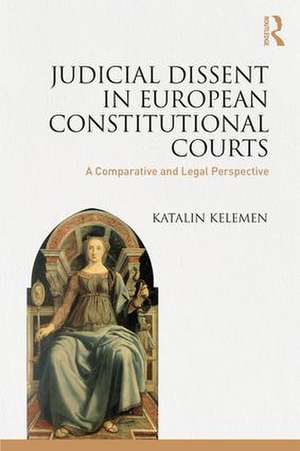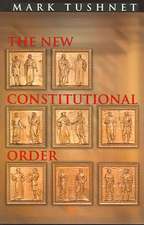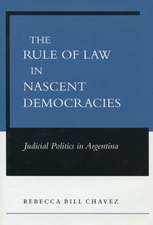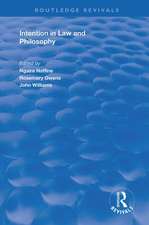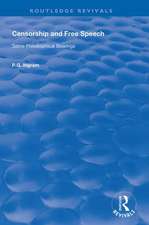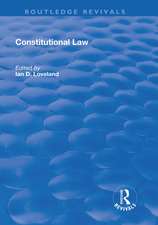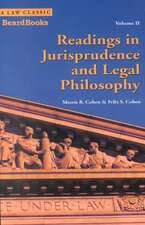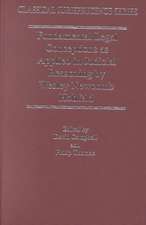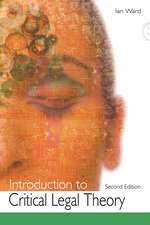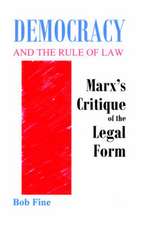Judicial Dissent in European Constitutional Courts: A Comparative and Legal Perspective
Autor Katalin Kelemenen Limba Engleză Hardback – 18 sep 2017
| Toate formatele și edițiile | Preț | Express |
|---|---|---|
| Paperback (1) | 388.04 lei 6-8 săpt. | |
| Taylor & Francis – 11 sep 2019 | 388.04 lei 6-8 săpt. | |
| Hardback (1) | 934.94 lei 3-5 săpt. | +20.62 lei 7-13 zile |
| Taylor & Francis – 18 sep 2017 | 934.94 lei 3-5 săpt. | +20.62 lei 7-13 zile |
Preț: 934.94 lei
Preț vechi: 1027.40 lei
-9% Nou
Puncte Express: 1402
Preț estimativ în valută:
178.90€ • 187.29$ • 148.03£
178.90€ • 187.29$ • 148.03£
Carte disponibilă
Livrare economică 15-29 martie
Livrare express 01-07 martie pentru 30.61 lei
Preluare comenzi: 021 569.72.76
Specificații
ISBN-13: 9781472482235
ISBN-10: 1472482239
Pagini: 226
Ilustrații: 6 Tables, black and white
Dimensiuni: 152 x 229 x 17 mm
Greutate: 0.45 kg
Ediția:1
Editura: Taylor & Francis
Colecția Routledge
Locul publicării:Oxford, United Kingdom
ISBN-10: 1472482239
Pagini: 226
Ilustrații: 6 Tables, black and white
Dimensiuni: 152 x 229 x 17 mm
Greutate: 0.45 kg
Ediția:1
Editura: Taylor & Francis
Colecția Routledge
Locul publicării:Oxford, United Kingdom
Cuprins
Introduction
Chapter I: Judicial dissent: What is it and why does it matter?
1. Judicial dissent and dissenting opinions: A definition
2. Judicial dissent in legal research: An object or a tool?
3. The sui generis nature of constitutional courts
Chapter II: The decision-making process in constitutional courts
1. Internal court structure in comparative perspective
2. The prominent figures of the decision-making process
2.1. The president of the Court
2.2. The most prominent members of the decision-making panel: The rapporteur judge and the opinion-writer
2.3. Non-judicial offices: Law clerks and the Secretary General
3. Judicial style in constitutional courts
Chapter III: Judicial dissent in the common law tradition
1. Introductory remarks
2. The origins of the dissenting opinion
2.1. The historical roots: England
2.2. The ‘institutionalization’ of judicial dissent in the United States
2.3. The first Great Dissenters in the history of the U.S. Supreme Court
3. The practice of dissenting opinions in the common law tradition: England and the United States
3.1. The decision-making process: Two common law supreme courts compared
3.2. The role of law clerks in the decision-making process
3.3. Separate opinions and the doctrine of binding precedent. The problematic issue of plurality opinions
3.4. Dissent rates and judicial style in the US and the UK Supreme Courts
Chapter IV: Judicial dissent in the civil law tradition
1. Judicial decision-making in the civil law tradition: Founded on secrecy?
2. Judicial dissent in three Western European legal systems
2.1. Dissenting opinions in German constitutional justice
2.1.1. History
2.1.2. Practice
2.2. Voto reservado and voto particular: Dissenting opinions in Spanish constitutional justice
2.2.1. Votos reservados and votos particulares: The history of judicial dissent in Spain
2.2.2. The practice of dissenting opinions in the Tribunal Constitucional
2.3. Attempts of introducing dissenting opinions in Italian constitutional justice
3. Judicial dissent in the European courts
3.1. Dissenting opinions in Strasbourg. The practice of the European Court of Human Rights
3.2. The absence of dissenting opinions in Luxembourg. The practice of the Court of Justice of the European Union
3.3. Comparative excursus: Dissenting opinions in The Hague. The practice of the International Court of Justice
3.4. Comparative remarks
4. Judicial dissent in East-Central European constitutional courts
4.1. A new generation of constitutional courts: Why to treat them separately?
4.2. Law in the books: The rules concerning judicial dissent
4.2.1. The Baltic story: three degrees of openness
4.2.2. The Slovak story: precedent becomes law
4.2.3. The Yugoslav story: a separate way
4.3. Law in action: The use of dissenting opinions
4.3.1. What do the numbers show?
4.3.2. The role of dissenting opinions in the development of constitutional law
5. A country study: The use of dissenting opinions in the Hungarian Constitutional Court (1990-2010)
5.1. The challenges of a quantitative analysis
5.2. The data on separate opinions from 1990-2010
5.3. The two forms of separate opinion: dissents and concurrences
5.4. Why does a judge decide to write separately?
5.5. The style of separate opinions
5.6. The internal dynamics of decision-making
5.7. When a dissenting opinion becomes precedent
5.8. Conclusion
Chapter V: Comparative reflections
1. The publication of judicial dissent: pros and cons
2. Independence vs. transparency: A difficult balance
2.1. Dissenting opinions and judicial independence
2.2. Dissenting opinions and transparency of decision-making
3. Judicial dissent and legal certainty
3.1. Legitimacy, the majority principle and the ‘consistency’ element of legal certainty
3.2. The ‘predictability’ element of legal certainty
3.3. Legal certainty and the different schools of legal theory
3.4. A brief remark on the indeterminacy of constitutional law
4. The judges’ point of view
4.1. The internal effects of separate opinions
4.2. Judicial dissent and the freedom of expression
5. The role of dissenting opinions in the development of constitutional law
6. Conclusive remarks
Appendix: List of Western and East-Central European Constitutions, Constitutional Court Acts and Rules of Procedure of the respective constitutional courts
Bibliography
Chapter I: Judicial dissent: What is it and why does it matter?
1. Judicial dissent and dissenting opinions: A definition
2. Judicial dissent in legal research: An object or a tool?
3. The sui generis nature of constitutional courts
Chapter II: The decision-making process in constitutional courts
1. Internal court structure in comparative perspective
2. The prominent figures of the decision-making process
2.1. The president of the Court
2.2. The most prominent members of the decision-making panel: The rapporteur judge and the opinion-writer
2.3. Non-judicial offices: Law clerks and the Secretary General
3. Judicial style in constitutional courts
Chapter III: Judicial dissent in the common law tradition
1. Introductory remarks
2. The origins of the dissenting opinion
2.1. The historical roots: England
2.2. The ‘institutionalization’ of judicial dissent in the United States
2.3. The first Great Dissenters in the history of the U.S. Supreme Court
3. The practice of dissenting opinions in the common law tradition: England and the United States
3.1. The decision-making process: Two common law supreme courts compared
3.2. The role of law clerks in the decision-making process
3.3. Separate opinions and the doctrine of binding precedent. The problematic issue of plurality opinions
3.4. Dissent rates and judicial style in the US and the UK Supreme Courts
Chapter IV: Judicial dissent in the civil law tradition
1. Judicial decision-making in the civil law tradition: Founded on secrecy?
2. Judicial dissent in three Western European legal systems
2.1. Dissenting opinions in German constitutional justice
2.1.1. History
2.1.2. Practice
2.2. Voto reservado and voto particular: Dissenting opinions in Spanish constitutional justice
2.2.1. Votos reservados and votos particulares: The history of judicial dissent in Spain
2.2.2. The practice of dissenting opinions in the Tribunal Constitucional
2.3. Attempts of introducing dissenting opinions in Italian constitutional justice
3. Judicial dissent in the European courts
3.1. Dissenting opinions in Strasbourg. The practice of the European Court of Human Rights
3.2. The absence of dissenting opinions in Luxembourg. The practice of the Court of Justice of the European Union
3.3. Comparative excursus: Dissenting opinions in The Hague. The practice of the International Court of Justice
3.4. Comparative remarks
4. Judicial dissent in East-Central European constitutional courts
4.1. A new generation of constitutional courts: Why to treat them separately?
4.2. Law in the books: The rules concerning judicial dissent
4.2.1. The Baltic story: three degrees of openness
4.2.2. The Slovak story: precedent becomes law
4.2.3. The Yugoslav story: a separate way
4.3. Law in action: The use of dissenting opinions
4.3.1. What do the numbers show?
4.3.2. The role of dissenting opinions in the development of constitutional law
5. A country study: The use of dissenting opinions in the Hungarian Constitutional Court (1990-2010)
5.1. The challenges of a quantitative analysis
5.2. The data on separate opinions from 1990-2010
5.3. The two forms of separate opinion: dissents and concurrences
5.4. Why does a judge decide to write separately?
5.5. The style of separate opinions
5.6. The internal dynamics of decision-making
5.7. When a dissenting opinion becomes precedent
5.8. Conclusion
Chapter V: Comparative reflections
1. The publication of judicial dissent: pros and cons
2. Independence vs. transparency: A difficult balance
2.1. Dissenting opinions and judicial independence
2.2. Dissenting opinions and transparency of decision-making
3. Judicial dissent and legal certainty
3.1. Legitimacy, the majority principle and the ‘consistency’ element of legal certainty
3.2. The ‘predictability’ element of legal certainty
3.3. Legal certainty and the different schools of legal theory
3.4. A brief remark on the indeterminacy of constitutional law
4. The judges’ point of view
4.1. The internal effects of separate opinions
4.2. Judicial dissent and the freedom of expression
5. The role of dissenting opinions in the development of constitutional law
6. Conclusive remarks
Appendix: List of Western and East-Central European Constitutions, Constitutional Court Acts and Rules of Procedure of the respective constitutional courts
Bibliography
Notă biografică
Katalin Kelemen is Associate Professor in Law, Örebro University, Sweden.
Descriere
This book presents a comparative analysis of the practice of judicial dissent in constitutional courts. It discusses the theoretical background, presents the history of the institution and today’s practice, thus laying down the basis for an accurate consideration of the phenomenon.
